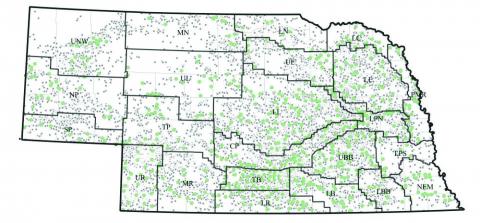Author’s Note: This article is by UNL Emeritus Soil Science Professor Charles Wortmann and originally appeared in the March 31 CropWatch newsletter.
The EC 3052 titled “Irrigation Well Water in Nebraska: Nutrient Concentrations and Other Properties” has been published
by UNL Extension and is available for free download. This
EC reports the results of a survey conducted in 2020 with
the cooperation of all 23 Natural Resources Districts and the Nebraska Department of Environment and Energy. It involved analysis of samples from 642 irrigation wells (map). The results are reported in 21 maps and additional figures and tables.
Nutrients and liming effect applied are reported as concentrations and as pounds applied in 10 acre-inches which
is then compared to the nutrients removed in the harvest of corn grain. The liming effect from irrigation is compared to amount of lime needed to neutralize the acidity produced by the application of 200 lb of fertilizer-nitrogen.
Statewide highlights include the percent of irrigation wells with a supply in 10 ac-in in excess of removal in 200 bu/ac of corn grain is:
- 100% for calcium and chloride
- 93% for magnesium
- 73% for sulfur
- 20% for potassium
- 16% for manganese or molybdenum
- 7% for boron
- <2% for zinc, copper, and iron
- 0% for phosphorus; and
- the liming effect exceeds acidification due to 200 lb fertilizer-N for 70% of wells.
Most of the remaining wells supply sufficient nutrients and liming effect to help maintain soil fertility and reduce the amount of fertilizer and lime application that is ultimately needed. None of the sampled wells had a high sodium problem and <0.5% had a salinity concentration. Water hardness was high enough with some wells that it might reduce the effectiveness of chemigation and cause formation of concretions on nozzles and pipes.
There is much variation between wells, so the testing of irrigation water for the supply of essential nutrients and liming effect is advised for each well or group of similar wells. This may only need to be done just once every 15 years, but is advised to help optimize nutrient and soil management.

